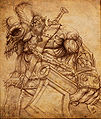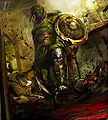Keishig
| Orc Keishig | |
|---|---|

| |
| Also Known As | The Orc Tribes |
| Organization Type | Horde |
| Leadership | Khan Bilge VII |
| Membership | Scarlet Moon Tribe; Rampage Tribe, Torghuds |
| Associated With | Ylisstol |
| Related To | Frozen North |
The Northern Orc Tribes are more like a series of related Orc encampments who can, at the call of their Khan, move as a single horde-like force. They have a long and proud warrior history, though a lot of that has been spent in an alternatively cold and hot war with the Frost Elves.
History
Originally, each village was a separate clan of Orcs and lived by their own traditions and beliefs, with an in-born need and lust for violence and battle, continuously clashing with one another, and starting selective breeding among their people, to produce the biggest and strongest offspring. Because of this, the average temperament and reasoning of Orcs tends to veer towards the brutish and vicious rather than the philosophical or peaceful, but they aren't exactly stupid, simply easily blinded to solutions that don't involve brutality.
Each tribe produced their champions and then waged war, with each other, with the Humans, and with the Elves. Because of this, the Orcs were considered a nuisance more than a threat. As phenomenally violent and vicious as they could be, a single tribe of Orcs would never organize itself well enough to match the military might of the Humans or the magic of the Elves. That all changed when the first true Orc warlord, Khan Bilge the First, was born. Bred to fight and trained in both war and mysticism, he realized that Orcs fighting Orcs would leave the Elves and Humans laughing all the way to the end. He took a chance and got himself captured by humans, allowing that so he could watch their training and spy on their strategies, then used his Shamanistic abilities to get himself free. Once out, he went back to his Tribe, and used his newfound knowledge to utterly crush a rival Tribe. Instead of destroying or assimilating them, he spared them all if they would join him and become the single strongest Orc tribe. While originally reticent, they accepted, and did not regret it.
Over the next 100 years, the Khan Bilge (as he became known) and his son organized the Orcs into a singular, horde-like fighting force, called the Keishig. Every tribe they conquered was made to join them, and soon enough other tribes sought him out after killing their retrograded elders. The great Orc Empire was born from there, and suddenly, the Elves and the Humans weren't laughing anymore. Generations of warmongering had made the Orcs incredibly strong, their lines bred for battle, and now they had organization and spread. Their attacks on the Humans and the Elves weren't massacres anymore. Several of them were captured and taken as Orc slaves. From this began the Orcs' desire to expand their Keishig from beyond the Frozen North. They knew how to do it, too. They would raid, pillage, and mate with (or rape) their conquests, adding Humans and Elves to their half-breeds and making them part of the Keishig, intending to spread Orcs among the royalty and nobility of every land, granting 'legal' tenure to their 'empire'. And once that happened, the Orcs would become the true rulers of the Frozen North and everything beyond.
Purpose

Organized more as loose, separated armies with their own rulership and fighting tactics, all united under a single Khan, originally there by blood but over time having become a position attained by strength and cunning more than the factor of birth, though by and large Bilge's lineage only produces amazingly strong children, the Orcs' Keishig is divided into the Day (Krotchin) and Night (Khevtuul) armies, with the Krotchin being the offensive force and the Khevtuul guarding their encampments and holdings. Orcs have, since then, added several different groups into their organizations, using Assassins, Shamans and Warlocks, and breeding many with an adventuring spirit. A few generations ago, the concept of 'Knights' even made their way to the Orcs, who, dismissive at first, eventually realized an armored, well disciplined fighting force was a good idea. The Khan established the Orcish Knighthood (Torghuds), as his own personal fighting force, with every knight fiercely loyal to the Khan, and every son of the current Khan who isn't a Shaman is required to serve as a Torghud, to instill both loyalty and honor into him.
Organization
Tribes/Clans
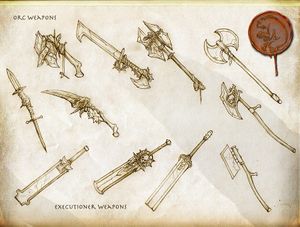
The basic social structure of the Orcs, each Orc is born to a Tribe, or Clan, which have been in the Frozen North since the dawn of time. Several Clans have been either wiped out, or assimilated over time, but those that remain are considered to be the strongest. Most Clans are named after one of three things. Their location, a great deed, or something someone associates to them, with names having changed over time. For example, one of the more vicious Clans, called the Scarlet Moon Clan, were originally called the Frost Wind Clan, until another Tribe's survivor said he'd seen the moon through so much blood it looked Scarlet. The Frost Wind Clan took the name as a point of pride and carry it to this day. Examples of Clan names: Scarlet Moon, Wild River, Bligespawn, Rampage, United Horde.
Tribes are the overall village/location of the Orcs. They are organized around a Chieftain, which generally rules both the military might and the day to day affairs of the Tribe, though it isn't unheard of for a wiser yet less brilliant Chieftain to delegate to more organized people or the local Shaman or Warlock to deal with the affairs of the Tribe. The Chieftain's responsibility (though many don't care) is to keep the Tribe fed, clothed and generally organized, as well as further the might of his Clan. Since most Orcs are bred for battle, this last part is relatively easy. The other aspects of an Orcish Tribe are similar to human hamlets, no matter how large the Tribe ends up being, with everyone working to further the Tribe more than their own benefit.. usually. The Orcs have a strong sense of community, though, and generally try not to screw each other over TOO much.
Tribes and Clan are fiercely proud, and fly their flags everywhere. Even if merely traveling, most Orcs will wear the colors of their tribe proudly, to be associated with them, regardless of their standing at the moment.
NOTE: The difference between Tribe and Clan is simple. The Tribe is the entire social structure/town of the Orcs, including women, children, workers and the whole community. The Clan is those involved in the war effort, with the warriors, Shamans and Warlocks, and are regarded as the cornerstone or Orc Society and the Keishig.
Shamans and Warlocks

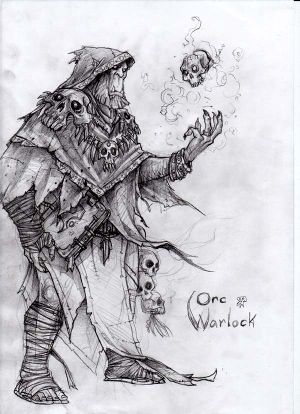
Orcs are not especially religious, but they are spiritually minded, to a degree, and well aware of the battles between Naga and Grima. However, Orcs believe in personal strength, and how one attains it is generally considered meaningless. Shamans are considered spiritual leaders and more enlightened among the Orcs, usually providing healing, guidance and spirituality to an otherwise war-mongering species. They are, traditionally, spiritualists who use the powers of the elements, the storm, and the forces of nature and beyond to placate their foes, heal their allies, and seek guidance from beyond. For a people whose entire meaning is strength, the rare wise man is a sight indeed, and their power and wisdom is unquestioned. Several Shamans are known to speak with and, in fact, BE one with their ancestors, granting them the wisdom of the ages. No wise Chieftain goes without counsel from a Shaman, even if they are as fiercely proud and independent as the rest of their race.
Warlocks, however, have been part of Orcish culture since before the time of the Khans, and are both feared and respected in equal amounts. In many ways the same as a Shaman, the difference is that Warlocks are, in fact, Orc Grimleal. They are an unpleasantly empowered bunch and are known to be cunning, deceptive, and power-hungry. All traits prized among the Orcs. While other cultures have shunned Grimleal, the basic line of thought for most Orcs, Warlocks included, is that strength is strength and results will ALWAYS matter more than methods. As such, while many wiser Shaman are wary of Warlocks, most (rightfully) attribute it to envy of their power. No Clan goes to war without a Warlock, and no Khan has ever been noteworthy without one of these backing him personally. Their magics are darker and more destructive than the more versatile Shaman, but Warlocks are unquestionably more powerful in battle. Most Tribes find a right balance between their Warlocks and their Shaman, because at the end, all of them care about the Orcs and each Orc seeks might.
Half-Orcs and The Keishig
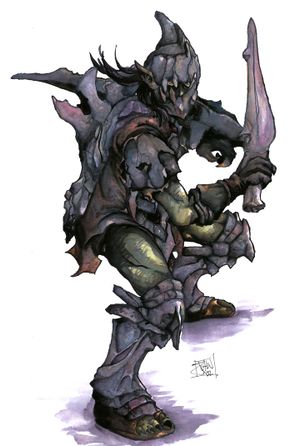
Half-Orcs are a very common occurrence among most Tribes, due to the Orcs and the Keishig's expansionist policies, more than a third of the tribe is usually composed of Half-Orcs, most of them of Elven, and then Human origin. Orcs breed true, and no child with Orc blood will look like they have Orc blood in them, with a greenish or greyish tinge to their skin, and a protuberant jaw. Their features are usually softer than the coarser and rougher Orcish traits. Due to the Orc way of expanding their Keishing, Half-Orcs, originally used for labor or killed, are now trained to be part of their Tribe. They are, generally, treated with a certain level of disdain and prejudice.. until they can kick the crap out of their tormentors, which is when the Half-Orc becomes a full fledged member of the Clan. Due to their generally smaller stature, many Half-Orcs choose to do more roguish roles in their clan, or become Torghuds, which is even more physically demanding, but will put them above even their fellow full blooded brothers, and is the ultimate mark of both respect and loyalty. Even the most racist and discriminatory Orc will think twice before giving a Torghud a hard time.
Torghuds
An order of Orcish knights, loyal to the Keishig and working directly under the Khan. The Torghud were founded based on Human knightly orders, which was an idea originally opposed by Orcs. Their might had always been personal and physical, not through any kind of artificial code of enforced unity. However, the idea of getting organized directly under the Khan did appeal to several less physically powerful but more even-tempered Orcs, and several Half-Orcs, making the Torghud start from a small but noticeable order, into the most potent fighting force of the Orcish Keishig. Ironically, their unity and discipline has mostly fallen to the wayside, with individual knights being exceptionally skilled and powerful, regardless of their origins. They only organize as a group during Orcish campaigns, but generally act as envoys from the Khan and slayers of the Orcs' enemies, such as Giants and White Dragons.
The highest honor an Orc can get is to become a Torghud, as their legacy and lineage is assured when they get past the demanding, grueling tests, and become personal servitors of the Khan. While several Orcs would rather be a Chieftain or jarughachi, those who aren't born especially strong, or are from an as-yet-unknown lineage have nowhere to go but up as a Torghud. The demands on a knight are many, and they have limitations, such as being unable to become a Chieftain, but their prestige and set of skills makes them the most valuable Orcs on the battlefield, or on an adventure.
Orc Hierarchy
The Orcs have a simple hierarchy. Whoever is the strongest is the boss. It's a rather simple model that gets subverted occasionally, such as a raid leader being in charge for his cunning and the loyalty owed to him by his troops, or an unscrupulous manipulator being held in place via blackmail and threats.. which never lasts very long, as the Orcs' sense of community will not take kindly to this kind of behavior. While a crafty or deceitful Orc can hold a position for a time, it can only be used against other duplicitous Orcs, and only until the others find he's outlived his usefulness. Merit is its own qualifier, after all.
The overall Keishig Hierarchy is rather simple due to this. Most Orcs simply hold a contest of strength and whoever wins, or whoever shows up with the most troops, tends to boss the others around technically, though their Clan-based warfare means the Orcs will usually do their own thing and follow overall orders when appropriate.. or not, which can cause problems, but that's not relevant here.
- Khan: The King of the Orcs. His word is law, he is the unifying force around which the Keishig is built, and he is the one who hands out rules and laws the Orcs are supposed to live by. His is the final verdict in any dispute, and he is expected to be a general, a politician, a judge, and a wise man. Many Orcs aspire to the position of Khan, but no Orc will follow a Khan who cannot prove himself in battle, warfare, and politics, meaning the position of Khan is safe from assassins and petty infighting. Due to Khan Bilge's foresight, and that of his Shamans, his rules of conduct to the position of Khan are FIERCELY enforced by the advisers, and vice-versa, the Khan makes sure the advisers don't overstep their bounds, making the position one with as much responsibility as power. A tyrannical despot is a fine Khan, provided he doesn't turn his might against the Orcs, which is why the Torghuds are loyal to the office of the Khan, not the Khan himself. It's worked well so far.
- Jarughachi: The Warchief. These are people directly under the Khan, taken from positions of Chieftain, Torghuds or even random adventurers that the Khan has singled out for duty. They are in charge of any war effort, assembling different clans under them. They have the power to gather troops from their clans and associated others to act as a personal army, but those are a guard, and not an actual military force that could invade any of the Clans or wage war on their own. The Jarughachi are chosen for their fierceness in battle as much as their strategic acumen. They are the people in charge of a set group of Tribes, acting as 'boss' to them and relaying the Khan's orders. They are occasionally used as judges to settle disputes between their assigned tribes, and are expected to know the strengths and weaknesses of every Clan under them. This position is assigned to whom the Khan considers the best choice for the job, and all Tribes are expected to pay him respect.
- Chieftain: The basic leader of a Tribe and Clan of Orcs. This is, by and large, the strongest and most cunning Orc in any Tribe. They rise to the top by wanting it more, and get there through force or arms and the ability to sway other Orcs. This is an elected position, as much as it can be, as the strongest Orc in the Tribe may be too dumb to rule, and the smartest may not gain the respect of his peers. As such, the Chieftain is (almost) democratically put in place by Orcs accepting this one as their leader. The Chieftain is in charge of Clan warfare and Tribal well-being. Generally, this is a position of 'Boss', and most Chieftains are in fact, content to let their people do whatever they want, provided they follow the Orcish way of life. A wise Chieftain will surround himself with Shamans and a Warlock.
- Raid Leader: It's customary for the Chieftain to name their chief rival as the Raid Leader, and give him a strong position within the Clan, if only because Orcs believe competition breeds excellence. Moreover, it's considered a compromise, and wastes no valuable Orcs. The Raid Leader is in charge of rallying, organizing, and obviously, leading troops. While the assignment to this position may cause the Raid Leader to butt heads with the Cheiftain, Orcs believe this is for the best, as aggression leads to competence to outshine the other. While the Chieftain is officially in charge of the war effort, most soldiers interact with the Raid Leader and view him as their boss, deferring to the Chieftain as tradition and respect. It is said most bitter rivals end up making the best pairs and the greatest of friends after a few battles together. The Raid Leader can be from all walks of life, though generally, it will be a powerful warrior. The Raid Leader can also name 'Whips', known to represent him with away parties, giving a minimal amount of power to them, over individual groups among the war effort. They are also occasionally called Pack Leaders.
- Shaman: The Orc equivalent to a priest, counselor and doctor. As discussed above, the Shaman has several duties within the Tribe and clan. It is customary that 2/3 of all Shamans join whatever war effort is going on, while the others remain behind to both guard the Tribe and provide spiritual guidance and security to the women and children left behind. Shaman are highly respected, because even the weakest of Orcs has to endure the grueling test of spirits to become a Shaman, and their weaker bodies are often the result of that, meaning they are an odd sight among larger, more brutish Orcs, but every Orc knows the strength of the Shamans. They often act as community leaders among the Tribes, and while they officially do not outrank anyone, only the dimmest and most ill-advised of Chieftain and Raid Leader doesn't listen to a Shaman's warnings. Within the Shamans, there is a loose hierarchy, in which the most powerful Shaman is second to the wisest, and the rest is based on seniority. There is surprisingly little infighting, but Shamans see each other for their spiritual strength and know their place.
- Warlock: The black sheep of the Orc Tribe, Warlocks are feared more than they are respected, but their power makes sure they ARE respected. Rarer and far less organized than the Shamans due to their ..well, scarcity, the Warlocks hold no official power within the Tribe, though many act as morticians or other unsavory workers in Orc Tribes. When a Shaman is unavailable, a Warlock is sought out as a doctor, though of the more scientific kind, and they are, even above Shamans, known as keepers of lore, and the only ones who hold anything like libraries among Orc Tribes. Generally speaking, a Warlock is unofficially equal to a Shaman in most villages, but the greater number of Shaman gives them more power, which seems fine with many Warlocks, who would rather have mystical than temporal power, and gain their abilities for war and knowledge rather than the Tribal humdrum of daily life. No Orc, however, will cross a Warlock, and as such they often hold considerable sway in their Tribe.
- Clan Orc: Orcs who are part of the Clan, the warrior Orcs. Not much is to be said about them, but in the social hierarchy of the Orcs, most men aren't considered as such until they join the Clan. From there, all benefits of being a true Orc are unlocked. The right to claim land and women, the right to stand among peers and the right to die in glorious battle. Almost all male Orcs are expected to join the Clan in some capacity or another. Every single Orc that joins the Clan is required to be strong, and all Clansorcs are treated equally, from the lowliest Half-Orc thief to the most brutal giant of an Orc warrior. In theory. Obviously, in practice, Orcs believe might makes right, but once an Orc is part of the Clan, it's expected that every other Orc in the Clan views them as a brother and an equal, and the first part is mostly respected. Non-Clan Orcs look up to them and they get a wide berth, but in a society of warriors and bred for battle, the Clan Orc is the logical choice to be.
- Tribal Orc: The rank and file of the Orc community. Each of them is expected to work for the Tribe, and join the Clannish war efforts whenever they come up. They serve as Blacksmiths, Breeders, animal tenders, hunters, and the like. The Orcs are a hunter/gatherer society like Humans, and as such are comparable to tribal Humans, with the exception that every Orc is bred for war and is expected to join the war effort somehow. Duties related to war are also considered respectable alternatives, making weapons and tracking food are a necessity, but if an Orc family has more than one son, at least one is expected to become a full fledged Clan warrior. The women and children are usually kept at home, and it's not unknown that women take important positions behind the scenes. Several Orc women join the Clan, in some capacity, though Orcs understand that there's no real point to war if there's nothing to come back to. As with ALL things in Orc society, a woman who can kick the crap out of someone is treated with more respect than the one whose ass got kicked.
Known Members
- Khan Bilge VII:
- Queen Ilyandra:
- Jarughachi Azubak:
- Jarughachi Gubdagog:
- Jarughachi Zurpigig:
- Aghed:
- Quomauog:
Gallery
-
Orc Warrior.
-
Orc Warrior.
-
Orc Warrior.
-
Orc Warrior.
-
Orc Shaman.
-
Orc Warlock.
Trivia
- These Orcs are based on Genghis Khan's Mongol Horde. Which is apparently what Tolkien based them on, so there's that.
